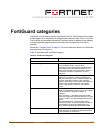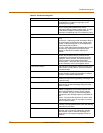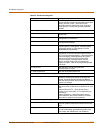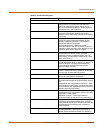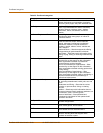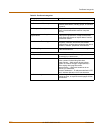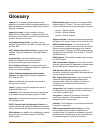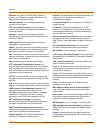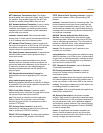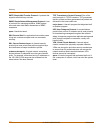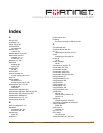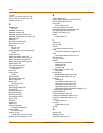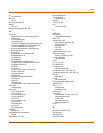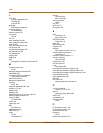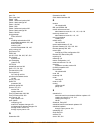
364 01-28007-0068-20041203 Fortinet Inc.
Glossary
Ethernet: Can refer to the IEEE 802.3 signaling
protocol, or an Ethernet controller (also known as a
Media Access Controller or MAC).
external interface: The FortiGate interface that
connects to the Internet.
FTP, File Transfer Protocol: A protocol used to
transfer files between computers that have different
operating systems.
gateway: A combination of hardware and layer-3
(network-layer) software that relays packets from one
network to another.
hash algorithm: A procedure that renders a text
message as a unique number.
header: The part of a packet that includes the source
and destination address of the associated data. This
addressing information is used to route packets.
hop: The segment of packet transmission that occurs
between two routers. A packet may make several hops
as it travels to its destination.
host: A network entity that has an IP address.
HTTP, Hypertext Transmission Protocol: The
protocol used by the World Wide Web. HTTP defines
how messages are formatted and transmitted, and
what actions Web servers and browsers should take in
response to various commands.
HTTPS: The secure HTML protocol for transmitting
encrypted information to web servers using SSL. See
also SSL.
hub: A device where communication links are brought
together to exchange data between several computers.
ICMP, Internet Control Message Protocol: An IP
message control protocol that supports error
messages, test packets, and information messages
related to IP. This protocol is used by the ping
generator to send ICMP echo requests to a host.
IKE, Internet Key Exchange: A method of
automatically exchanging IPSec authentication and
encryption keys between two secure servers.
IMAP, Internet Message Access Protocol: An
Internet email protocol that allows access to an email
server from any IMAP-compatible browser.
internal interface: The FortiGate interface that
connects to an internal (private) network.
Internet: The network that encompasses the world. As
a generic term, it refers to any collection of
interdependent networks.
IP, Internet Protocol: The component of TCP/IP that
handles routing.
IP address: The point of attachment to a TCP/IP
network. An IP address is a 32-bit quantity written in
dotted decimal notation (four numbers separated by
periods). See also netmask.
IPSec, Internet Protocol Security: A set of protocols
that support secure exchange of packets at the IP
layer. IPSec is most often used to support VPNs. See
VPN.
ISP, Internet Service Provider: A company that
provides customers with access to the Internet.
KB, kilobyte: A unit of storage (1 024 bytes).
L2TP, Layer 2 Tunneling Protocol: A security protocol
that enables ISPs to establish VPN tunnels on behalf of
dialup clients.
LAN, Local Area Network: A computer network that
spans a relatively small area.
Layer 2: The data-link layer of the OSI model. Layer 2
is responsible for transmission, framing, and error
control over a single link.
Layer 3: The network layer of the OSI model. Layer 3
is responsible for examining each network packet and
sending them to the proper destination over the
Internet.
local: The near end point (an IP address or port
number) of a connection.
MAC address, Media Access Control address: A
layer-2 hardware address that uniquely identifies a
network node.
main mode: A way to hide the identities of VPN peers
from passive eavesdroppers during IPSec phase 1
negotiations. See also aggressive mode.
MB, Megabyte: A unit of storage (1 048 576 bytes).
MIB
, Management Information Base: A database of
objects that can be monitored by an SNMP network
manager.
modem: A device that converts digital signals into
analog signals and back again for transmission over
telephone lines.




